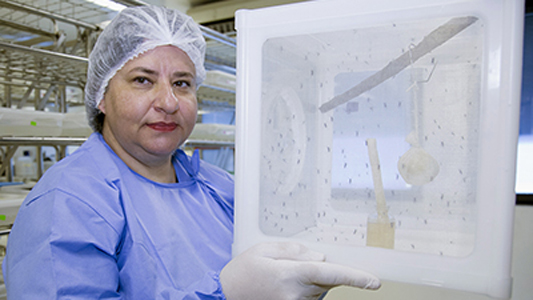Study assesses potential for urbanization of yellow fever
31/07/2017
Maíra Menezes (IOC/Fiocruz)
A study led by the Oswaldo Cruz Institute (IOC/Fiocruz) in partnership with the Pasteur Institute in France points to the potential of re-emergence of the urban transmission of yellow fever in Brazil, reinforcing the importance of preventive measures such as vaccination and vector control. In laboratory, scientists measured the efficacy of urban and wild mosquitoes in Rio de Janeiro with regards to the potential of transmitting the yellow fever virus. The data indicate that Rio de Janeiro insects of the species Aedes aegypti, Aedes albopictus, Haemagogus leucocelaenus, and Sabethes albipirvus are highly susceptible to viral strains from both Brazil and Africa. The vector competence of Aedes mosquitoes was also verified in Manaus, and, to a lesser degree, in Goiania. The transmission capacity of these vectors was also confirmed for the city of Brazzaville, the capital of Congo.
Mosquitoes of the genus Aedes, Haemagogus and Sabethes have been known for decades by science as vectors of the yellow fever virus. However, their efficiency in disseminating the disease may vary due to the diversity of insect populations and the combination between insects and different viral strains. That is why local analyzes, such as the one just completed, are important. "Currently, Brazil faces an epidemic due to the cycle of wild transmission of yellow fever. However, we must be vigilant about the potential for virus spread by urban mosquito species. That is why studies like this are fundamental," says Ricardo Lourenço, the head of Laboratório de Mosquitos Transmissores de Hematozoários of IOC [Laboratory of Transmitters of Hematozoa] and one of the coordinators of the research. "The data indicate that in the event that the virus is introduced into the urban area of Rio de Janeiro by an infected traveler, there are multiple opportunities for beginning local transmission," the researcher adds. Published in the international journal Scientific Reports, the work also had the collaboration of Instituto Evandro Chagas, in Pará.

Ricardo Lourenço leads the Laboratory of Transmitters of Hematozoa of IOC and coordinated the study (Picture: Gutemberg Brito)
In order to prevent the overflow of the disease from the wild to the urban cycle, the study stresses that it is essential that people in contact with forest areas where there is circulation of the wild form of the disease are immunized. Moreover, considering the risk of introduction from other endemic countries, the vaccination requirement for travelers visiting Brazilian cities should be evaluated. "Eliminate breeding sites and control the proliferation of Ae. aegypti is another important measure to avoid the re-emergence of urban yellow fever in Brazil, in addition to the basic and widely known issue of being responsible for the transmission of dengue, zika and chikungunya viruses," entomologist Dinair Couto Lima says, who is a researcher from the same lab and first author of the article.
Vector competence tests
The study included Ae. aegypti and Ae. albopictus mosquitoes from regions of Brazil with varied epidemiological characteristics in relation to the circulation of the yellow fever virus. In the Amazon, where the wild form of the disease is endemic - that is, cases are recorded in a sustained way - insects from Manaus were collected and tested. In the Central-West Region, which records cyclical outbreaks of wild yellow fever and is designated as a transition area between the endemic region and areas free of disease in the country, mosquitoes were captured in Goiânia. But in the southeast coast, where there were no case reports for more than 70 years, until the outbreak started at the end of 2016, researchers chose Rio de Janeiro for the collections. In this case, besides the Aedes, wild mosquitoes of the species Hg. leucocelaenus and Sa. albipirvus were evaluated. The work also analyzed insects Ae. aegyptie Ae. albopictus collected in Brazzaville, Congo, where wild yellow fever is endemic, but caused by viral lineages different from those detected in Brazil.
With regard to yellow fever viruses, among the seven genotypes circulating in the world, the study included the South American lineage 1, predominant in Brazil, including the subtype 1D, responsible for the majority of cases up to 2001, and the subtype 1E, majority in recent years. A lineage from West Africa, isolated in Senegal, was also used.
To carry out the tests, the researchers collected mosquito eggs in the cities and forest areas. Only in the case of Sa. Albiprivus, insects in a colony kept at IOC laboratory since 2013 were studied. After hatching the eggs, the mosquitoes were separated by species and genus. Groups of females were fed on blood samples containing yellow fever viruses of different strains. The transmission capacity of the insects was measured by the presence of infectious virus particles - capable of causing infection - in insect saliva after the ingestion of the virus blood. When the Brazilian viral strains were tested, the potential for disease spread was confirmed for all mosquito populations. Only Ae. albopictus from Manaus were not able to transmit the African viral lineage.
In addition to confirming the potential for transmission of yellow fever in different regions, the study points out that the efficiency to spread the virus varies among mosquito populations. Among the Brazilian urban vectors, Ae. aegypti from Rio de Janeiro presented the greatest potential to spread the disease, with more than 10% of the mosquitoes presenting infective viral particles in saliva 14 days after feeding regardless of the viral lineage considered. “In general, we find that Ae. aegypti and Ae. albopictus from Rio de Janeiro and Manaus were more susceptible to transmitting yellow fever viruses, while the insects from Goiânia were able to spread the disease, but much less efficiently," Ricardo says.
Wild vectors from Rio de Janeiro presented even greater capacity for dissemination of the disease. Depending on the lineage of the virus considered, 10% to 20% of Hg. leucocelaenus presented infectious particles in saliva 14 days after the ingestion of infected blood. But among Sa. albipirvus, this percentage ranged from 23% to 31%. Similar levels of vector competence were observed among Ae. aegypti and Ae. albopictus mosquitoes from Brazzaville, in Congo, which according to scientists, reinforces the potential for the transmission of urban yellow fever in West Africa as well. According to Dinair Couto, behavioral characteristics of Ae. Aegypti and Ae. Albopictus mosquitoes can contribute to the reurbanization of the disease.
Comparisons of transmission potential
The data indicate that the vector competence of Aedes mosquitoes to transmit yellow fever is lower than for the dissemination of other arboviruses. In 2014, a study also led by IOC in partnership with the Pasteur Institute pointed out that 80% of Ae. aegypti and 95% of Ae. albopictus from some populations in the Americas have the potential to transmit chikungunya virus only seven days after ingesting infected blood. Regarding the zika virus, a research published by the same group of scientists in 2016 indicated that 60% to 93% of Ae. Aegypti from Rio de Janeiro can spread the disease, 14 days after ingestion of blood infected with isolated viral lineages in the state. However, according to the scientists, considering the behavioral habits of Ae. Aegypti, and the high frequency of this vector in Brazilian urban environments, the levels verified in the research are sufficient to indicate the risk of urban transmission of yellow fever.
According to researchers, Ae. aegypti has a high potential for spreading diseases due to constant contact with people: the mosquito establishes its breeding grounds in or near the residences and feeds preferentially on human blood. Thus, the scenario observed in Rio de Janeiro, where the highest levels of vector competence of urban mosquitoes were verified, besides the high transmission capacity of wild insects, reinforces the need for alertness. "Yellow fever is on the doorstep of the most populated cities on the Brazilian Atlantic coast, zone with one of the highest human densities in all of South America. The epidemic recorded in Angola, Africa, last year exemplifies the threat posed by this. From Angola, the disease has reached neighboring countries such as the Democratic Republic of Congo and Uganda. Most of the cases were recorded in cities, suggesting the participation of urban vectors, especially Ae. Aegyptifed," Ricardo says.
Found in forests, rural environments, backyards and peri-domiciles, Ae. albopictus can also contribute to the urbanization of yellow fever. According to the scientists, these mosquitoes reproduce in areas with greater vegetation cover, and usually they bite wild and domestic animals, as well as mankind. "Ae. albopictus mosquitoes can move easily from the forest to peri-urban sites, and the highest rates of infestation by this species in Brazil are reported in the Southeast and South regions, where yellow fever is currently circulating. Thus, we must consider the hypothesis that Ae. Albopictus insects can play the role of 'bridge vector', linking the wild cycle to the urban cycle of the disease," Dinair ponders.

According to entomologist Dinair Couto, Aedes albopictus mosquitoes might connet the urban and the rural yellow fever cycles (Picture: Gutemberg Brito)
In peri-domiciliary areas, the same measures adopted against Ae. aegypti are important to fight Ae. Albopictus, including avoiding the accumulation of standing water in bottles, dishes of plants and other objects left in backyards, as well as maintaining gutters, installing screens in drains in these environments, and maintaining water tanks and other deposits well closed. Vaccination, in the places where immunization is indicated by the Ministry of Health, is also essential for the prevention of yellow fever.


